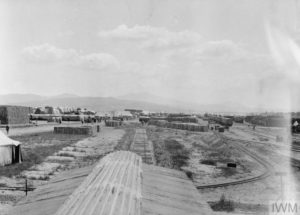Wednesday April 17th, 1918
Stood down 4:30. Lost our blankets. Breakfast 7am. Down to it by 8am. 1pm no work. Very hot. Dinner 5pm – very good. Stood to 6:45 went on post #4 at 7:45. Very cold after 12am. Johnny sweeps our post with machine gun – very near but quite safe.
Blankets
Despite the continued changeability of the weather, it looks like one of Frank’s two blankets has been returned to the Quartermaster. The pronouncements by Mr Macpherson, Undersecretary of State for War, in the House of Commons on February 20th might have therefore come as a surprise to Frank.
As reported in The Guardian the following day, ‘The War Office [in 1917] was the biggest wool and textile concern in the world. Its production was considerably in excess of the total pre-war output. It had purchased 250,000,000 yards of material, and for every hundred blankets purchased for all purposes in this country before the war 250 were purchased for direct Government service alone. The expenditure on wool was £88,000,000. The entire British wool clip had been purchased direct from the farmer, and arrangements had also been made with the New Zealand and Australian Governments to take over their clips. Similar arrangements had been made as regarded the Falkland Islands.’¹
The Cost of War

The above information just covers wool and textile, when one extrapolates to include munitions and manpower, underwriting the international merchant fleet etc, the financial cost of the war are enormous.
The photograph shows a railway in the process of construction at Dudular Supply Dumps. There were nine different depots for the BSF in Salonika. Note the amount of supplies shown.
As reported in the Guardian at the beginning of April, 1918, ‘Large as the year’s revenue has been, it is, of course, trifling compared with the expenditure chargeable against it, which has been £2,696,221,405 as against a Budget estimate of £2,290,381,000. The national debt a year ago had reached £4,011,445,908 and to this a deficit of £1,988,968,840 in the past year has to be added, making the total about six thousand million pounds.’²
The article continued, ‘From this should be deducted such sums lent or advanced to Allies and Dominions as are recoverable. A year ago it was stated that we had lent £822,000,000 to Allies and advance £142,000,000 to our Dominions, and, in moving the Vote of Credit last month, the Chancellor of the Exchequer stated that in 1917-18 loans to Allies and Dominions had been £229,000 above the Budget estimate, which was apparently £400,000,000. He added that, including loans, the total recoverable expenditure of the year was £206,750,000.’ ²
Paying off the Debt
In March, 2015, the British Government repaid the outstanding £1.9bn of debt from a 3.5% War Loan on 9 March 2015. The original loan was at 5%, but was refinanced in 1932 at 3.5%. More than 120,000 investors still held these War Loan bonds. Since 1917, the government had paid about £5.5 billions in interest. In 1918 this would have been reported as ‘five and a half thousand million pounds’ as, until mid-to-late 20th century, in UK English a ‘billion’ was defined as a ‘million million’. In US English a ‘billion’ has always been a ‘thousand million’.
Crow Hill, Ref Maps Dojran Edn 3A 1:20,000, Kilindir Pobreg 1:20,000
13th (Service) Battalion War Diary – 17th April 1918 – Crow Hill
Our artillery was moderately active on White Pillar Ridge, Little Donina, the Pip Ridge and Diamond Hill. Enemy artillery inactive on our front during day, at 22:30 hrs he fired 6 shrapnel on Goldies I from direction of White Scar Hill. Our planes passed over at 07:40 hrs and dropped bombs on enemy backward area returning safely. At 11:30 hrs 4 of our planes patrolled the enemy lines. At 11:30 hrs 2 enemy planes passed very high over Devedzelli Hill travelling west to east. They did not approach our lines.
A patrol of 1 & 3 visited trenches and wire on Kimberly Spor and found them in order. Another visited Goldies II, trenches are in good condition but the wire is broken down in several places. Goldies I was also visited without incident. A patrol of 1 NCO and 3 OR lay up for some time at point 1197/1814 ? Selimli Dere, nothing was seen or heard of the enemy. Ground is good for patrol work. Smoke was seen rising from behind Flat Iron Hill at 15:00 hrs. In addition to the tools mentioned on the 8th inst the following will be carried by Coys: Crow Bars 1, Axes Hammer-headed 1, Bill Hooks 1, Shovels 2.
References & Further Reading
¹’Committee of Supply’ about the Army Estimates, Mr Macpherson’s comments, The Guardian, February 21st, 1918, page 8
² ‘Year’s Expenditure’ in The Guardian, 1st April 1918, p4
* Q15150, copyright of the Imperial War Museums


